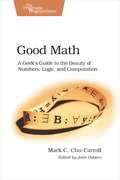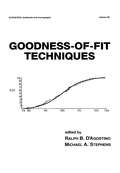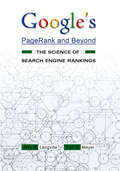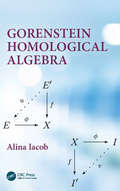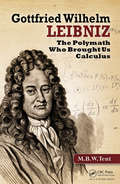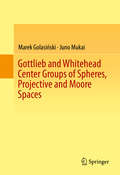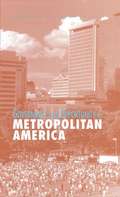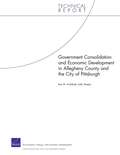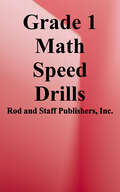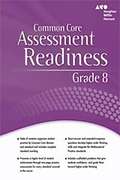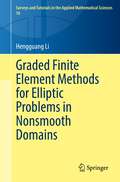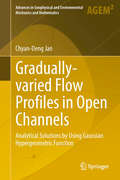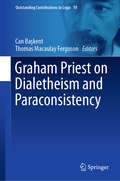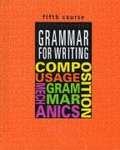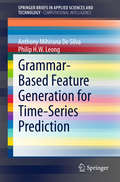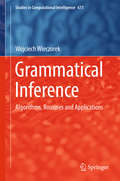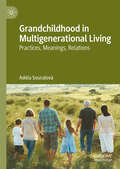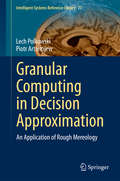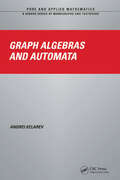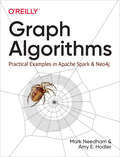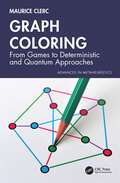- Table View
- List View
Good Math: A Geek's Guide to the Beauty of Numbers, Logic, and Computation
by Mark C. Chu-CarrollMathematics is beautiful--and it can be fun and exciting as well as practical. Good Math is your guide to some of the most intriguing topics from two thousand years of mathematics: from Egyptian fractions to Turing machines; from the real meaning of numbers to proof trees, group symmetry, and mechanical computation. If you've ever wondered what lay beyond the proofs you struggled to complete in high school geometry, or what limits the capabilities of computer on your desk, this is the book for you.Why do Roman numerals persist? How do we know that some infinities are larger than others? And how can we know for certain a program will ever finish? In this fast-paced tour of modern and not-so-modern math, computer scientist Mark Chu-Carroll explores some of the greatest breakthroughs and disappointments of more than two thousand years of mathematical thought. There is joy and beauty in mathematics, and in more than two dozen essays drawn from his popular "Good Math" blog, you'll find concepts, proofs, and examples that are often surprising, counterintuitive, or just plain weird.Mark begins his journey with the basics of numbers, with an entertaining trip through the integers and the natural, rational, irrational, and transcendental numbers. The voyage continues with a look at some of the oddest numbers in mathematics, including zero, the golden ratio, imaginary numbers, Roman numerals, and Egyptian and continuing fractions. After a deep dive into modern logic, including an introduction to linear logic and the logic-savvy Prolog language, the trip concludes with a tour of modern set theory and the advances and paradoxes of modern mechanical computing.If your high school or college math courses left you grasping for the inner meaning behind the numbers, Mark's book will both entertain and enlighten you.
Good Vibrations: The Physics of Music
by Barry ParkerWhy does a harpsichord sound different from a piano? For that matter, why does middle C on a piano differ from middle C on a tuning fork, a trombone, or a flute? Good Vibrations explains in clear, friendly language the out-of-sight physics responsible not only for these differences but also for the whole range of noises we call music.The physical properties and history of sound are fascinating to study. Barry Parker's tour of the physics of music details the science of how instruments, the acoustics of rooms, electronics, and humans create and alter the varied sounds we hear. Using physics as a base, Parker discusses the history of music, how sounds are made and perceived, and the various effects of acting on sounds. In the process, he demonstrates what acoustics can teach us about quantum theory and explains the relationship between harmonics and the theory of waves.Peppered throughout with anecdotes and examples illustrating key concepts, this invitingly written book provides a firm grounding in the actual and theoretical physics of music.
Goodness-of-Fit-Techniques
by RalphB. D'AgostinoConveniently grouping methods by techniques, such as chi-squared and empirical distributionfunction , and also collecting methods of testing for specific famous distributions, this usefulreference is the fust comprehensive.review of the extensive literature on the subject. It surveysthe leading methods of testing fit . .. provides tables to make the tests available . .. assessesthe comparative merits of different test procedures . .. and supplies numerical examples to aidin understanding these techniques.Goodness-of-Fit Techniques shows how to apply the techniques . .. emphasizes testing for thethree major distributions, normal, exponential, and uniform . .. discusses the handling of censoreddata .. . and contains over 650 bibliographic citations that cover the field.Illustrated with tables and drawings, this volume is an ideal reference for mathematical andapplied statisticians, and biostatisticians; professionals in applied science fields, including psychologists,biometricians , physicians, and quality control and reliability engineers; advancedundergraduate- and graduate-level courses on goodness-of-fit techniques; and professional seminarsand symposia on applied statistics, quality control, and reliability.
Google's PageRank and Beyond: The Science of Search Engine Rankings
by Amy N. Langville Carl D. MeyerWhy doesn't your home page appear on the first page of search results, even when you query your own name? How do other web pages always appear at the top? What creates these powerful rankings? And how? The first book ever about the science of web page rankings, Google's PageRank and Beyond supplies the answers to these and other questions and more. The book serves two very different audiences: the curious science reader and the technical computational reader. The chapters build in mathematical sophistication, so that the first five are accessible to the general academic reader. While other chapters are much more mathematical in nature, each one contains something for both audiences. For example, the authors include entertaining asides such as how search engines make money and how the Great Firewall of China influences research. The book includes an extensive background chapter designed to help readers learn more about the mathematics of search engines, and it contains several MATLAB codes and links to sample web data sets. The philosophy throughout is to encourage readers to experiment with the ideas and algorithms in the text. Any business seriously interested in improving its rankings in the major search engines can benefit from the clear examples, sample code, and list of resources provided. Many illustrative examples and entertaining asides MATLAB code Accessible and informal style Complete and self-contained section for mathematics review
Gorenstein Homological Algebra
by Alina IacobGorenstein homological algebra is an important area of mathematics, with applications in commutative and noncommutative algebra, model category theory, representation theory, and algebraic geometry. While in classical homological algebra the existence of the projective, injective, and flat resolutions over arbitrary rings are well known, things are a little different when it comes to Gorenstein homological algebra. The main open problems in this area deal with the existence of the Gorenstein injective, Gorenstein projective, and Gorenstein flat resolutions. Gorenstein Homological Algebra is especially suitable for graduate students interested in homological algebra and its applications.
Gottfried Wilhelm Leibniz: The Polymath Who Brought Us Calculus
by M. B. W. TentGottfried Wilhelm Leibniz: The Polymath Who Brought Us Calculus focuses on the life and accomplishments of one of the seventeenth century's most influential mathematicians and philosophers. The book, which draws on Leibniz's written works and translations, and reconstructs dialogues Leibniz may have had based on the historical record of his life ex
Gottlieb and Whitehead Center Groups of Spheres, Projective and Moore Spaces
by Marek Golasiński Juno MukaiThis is a monograph that details the use of Siegel's method and the classical results of homotopy groups of spheres and Lie groups to determine some Gottlieb groups of projective spaces or to give the lower bounds of their orders. Making use of the properties of Whitehead products, the authors also determine some Whitehead center groups of projective spaces that are relevant and new within this monograph.
Governance and Opportunity in Metropolitan America
by National Research CouncilAmerica's cities have symbolized the nation's prosperity, dynamism, and innovation. Even with the trend toward suburbanization, many central cities attract substantial new investment and employment. Within this profile of health, however, many urban areas are beset by problems of economic disparity, physical deterioration, and social distress.This volume addresses the condition of the city from the perspective of the larger metropolitan region. It offers important, thought-provoking perspectives on the structure of metropolitan-level decisionmaking, the disadvantages faced by cities and city residents, and expanding economic opportunity to all residents in a metropolitan area. The book provides data, real-world examples, and analyses in key areas: Distribution of metropolitan populations and what this means for city dwellers, suburbanites, whites, and minorities.How quality of life depends on the spatial structure of a community and how problems are based on inequalities in spatialopportunity--with a focus on the relationship between taxes and services.The role of the central city today, the rationale for revitalizing central cities, and city-suburban interdependence. The book includes papers that provide in-depth examinations of zoning policy in relation to patterns of suburban development; regionalism in transportation and air quality; the geography of economic and social opportunity; social stratification in metropolitan areas; and fiscal and service disparities within metropolitan areas.
Government Consolidation and Economic Development in Allegheny County and the City of Pittsburgh
by Sally Sleeper Rae W. ArchibaldThis report concludes that, although evidence is mixed and effects difficult to measure, consolidating the City of Pittsburgh and Allegheny County could enhance economic development by unifying leadership, improving policy direction and coordination, and sharpening economic-development initiatives. Increased collaboration with the private sector also is important, and combining only two governments still leaves the region highly fragmented.
Grade 1 Math Speed Drills: Beginning Arithmetic
by Rod and Staff PublishersThis small tablet of 72 speed drills provides timed practice of addition and subtractions facts. These drills begin at lesson 28 and continue through lesson 170. Speed drills are to be given every other day. Directions for using this tablet are in the teacher's manual.
Grade 5: Getting Ready for High Stakes Assessments
by Houghton Mifflin Harcourt Publishing CompanyGo Math! Getting Ready for High Stakes Assessments Student Edition Grade 5
Grade 7 Common Core Assessment Readiness
by Holt McdougalMathematics: Assessment Readiness Workbook Grade 7
Graded Finite Element Methods for Elliptic Problems in Nonsmooth Domains (Surveys and Tutorials in the Applied Mathematical Sciences #10)
by Hengguang LiThis book develops a class of graded finite element methods to solve singular elliptic boundary value problems in two- and three-dimensional domains. It provides an approachable and self-contained presentation of the topic, including both the mathematical theory and numerical tools necessary to address the major challenges imposed by the singular solution. Moreover, by focusing upon second-order equations with constant coefficients, it manages to derive explicit results that are accessible to the broader computation community. Although written with mathematics graduate students and researchers in mind, this book is also relevant to applied and computational mathematicians, scientists, and engineers in numerical methods who may encounter singular problems.
Graded Rings and Graded Grothendieck Groups
by Roozbeh HazratThis study of graded rings includes the first systematic account of the graded Grothendieck group, a powerful and crucial invariant in algebra which has recently been adopted to classify the Leavitt path algebras. The book begins with a concise introduction to the theory of graded rings and then focuses in more detail on Grothendieck groups, Morita theory, Picard groups and K-theory. The author extends known results in the ungraded case to the graded setting and gathers together important results which are currently scattered throughout the literature. The book is suitable for advanced undergraduate and graduate students, as well as researchers in ring theory.
Gradually-varied Flow Profiles in Open Channels
by Chyan-Deng JanGradually-varied flow (GVF) is a steady non-uniform flow in an open channel with gradual changes in its water surface elevation. The evaluation of GVF profiles under a specific flow discharge is very important in hydraulic engineering. This book proposes a novel approach to analytically solve the GVF profiles by using the direct integration and Gaussian hypergeometric function. Both normal-depth- and critical-depth-based dimensionless GVF profiles are presented. The novel approach has laid the foundation to compute at one sweep the GVF profiles in a series of sustaining and adverse channels, which may have horizontal slopes sandwiched in between them.
Graham Priest on Dialetheism and Paraconsistency (Outstanding Contributions to Logic #18)
by Can Başkent Thomas Macaulay FergusonThis book presents the state of the art in the fields of formal logic pioneered by Graham Priest. It includes advanced technical work on the model and proof theories of paraconsistent logic, in contributions from top scholars in the field. Graham Priest’s research has had a considerable influence on the field of philosophical logic, especially with respect to the themes of dialetheism—the thesis that there exist true but inconsistent sentences—and paraconsistency—an account of deduction in which contradictory premises do not entail the truth of arbitrary sentences. Priest’s work has regularly challenged researchers to reappraise many assumptions about rationality, ontology, and truth.This book collects original research by some of the most esteemed scholars working in philosophical logic, whose contributions explore and appraise Priest’s work on logical approaches to problems in philosophy, linguistics, computation, and mathematics. They provide fresh analyses, critiques, and applications of Priest’s work and attest to its continued relevance and topicality. The book also includes Priest’s responses to the contributors, providing a further layer to the development of these themes.
Grammar for Writing (Fifth Course Gr. #10)
by Phyllis Goldenberg Carol Domblewski Elaine Epstein Martin LeeThis book is designed to take the mystery out of grammar and to help you become a better, more confident writer.
Grammar-Based Feature Generation for Time-Series Prediction
by Anthony Mihirana De Silva Philip H. W. LeongThis book proposes a novel approach for time-series prediction using machine learning techniques with automatic feature generation. Application of machine learning techniques to predict time-series continues to attract considerable attention due to the difficulty of the prediction problems compounded by the non-linear and non-stationary nature of the real world time-series. The performance of machine learning techniques, among other things, depends on suitable engineering of features. This book proposes a systematic way for generating suitable features using context-free grammar. A number of feature selection criteria are investigated and a hybrid feature generation and selection algorithm using grammatical evolution is proposed. The book contains graphical illustrations to explain the feature generation process. The proposed approaches are demonstrated by predicting the closing price of major stock market indices, peak electricity load and net hourly foreign exchange client trade volume. The proposed method can be applied to a wide range of machine learning architectures and applications to represent complex feature dependencies explicitly when machine learning cannot achieve this by itself. Industrial applications can use the proposed technique to improve their predictions.
Grammatical Inference
by Wojciech WieczorekThis book focuses on grammatical inference, presenting classic and modern methods of grammatical inference from the perspective of practitioners. To do so, it employs the Python programming language to present all of the methods discussed. Grammatical inference is a field that lies at the intersection of multiple disciplines, with contributions from computational linguistics, pattern recognition, machine learning, computational biology, formal learning theory and many others. Though the book is largely practical, it also includes elements of learning theory, combinatorics on words, the theory of automata and formal languages, plus references to real-world problems. The listings presented here can be directly copied and pasted into other programs, thus making the book a valuable source of ready recipes for students, academic researchers, and programmers alike, as well as an inspiration for their further development. >
Grandchildhood in Multigenerational Living: Practices, Meanings, Relations
by Adéla SouralováGrandchildhood in Multigenerational Living: Practices, Meanings, Relations is the first book to sociologically analyse grandchild-grandparent relationships from the perspective of grandchildren. Expanding the knowledge about hitherto under-researched grandchildren, this book puts grandchildren’s perspectives in the centre of qualitative analysis focuses. Presenting grandchildhood in its complexity, the author addresses its multiple dimensions from 54 in-depth interviews with grandchildren living in three-generation households with their parents and grandparents. Drawing upon 'family practices', this book conceptionally develops ‘grandchild practices’ as a new approach to see the diversities and similarities, harmonies and tensions, joys and obligations, or, simply put, the daily ambivalences of family relationships. This unique book is an indispensable resource for researchers and students of family studies and sociology of generations who wish to investigate how grandchildren understand, negotiate and make sense of their relationships with grandparents.
Granular Computing in Decision Approximation
by Lech Polkowski Piotr ArtiemjewThis book presents a study in knowledge discovery in data with knowledge understood as a set of relations among objects and their properties. Relations in this case are implicative decision rules and the paradigm in which they are induced is that of computing with granules defined by rough inclusions, the latter introduced and studied within rough mereology, the fuzzified version of mereology. In this book basic classes of rough inclusions are defined and based on them methods for inducing granular structures from data are highlighted. The resulting granular structures are subjected to classifying algorithms, notably k--nearest neighbors and bayesian classifiers. Experimental results are given in detail both in tabular and visualized form for fourteen data sets from UCI data repository. A striking feature of granular classifiers obtained by this approach is that preserving the accuracy of them on original data, they reduce substantially the size of the granulated data set as well as the set of granular decision rules. This feature makes the presented approach attractive in cases where a small number of rules providing a high classification accuracy is desirable. As basic algorithms used throughout the text are explained and illustrated with hand examples, the book may also serve as a textbook.
Graph Algebras and Automata (Chapman & Hall/CRC Pure and Applied Mathematics)
by Andrei KelarevGraph algebras possess the capacity to relate fundamental concepts of computer science, combinatorics, graph theory, operations research, and universal algebra. They are used to identify nontrivial connections across notions, expose conceptual properties, and mediate the application of methods from one area toward questions of the other four. After
Graph Algorithms
by Guy Even Shimon EvenShimon Even's Graph Algorithms, published in 1979, was a seminal introductory book on algorithms read by everyone engaged in the field. This thoroughly revised second edition, with a foreword by Richard M. Karp and notes by Andrew V. Goldberg, continues the exceptional presentation from the first edition and explains algorithms in a formal but simple language with a direct and intuitive presentation. The book begins by covering basic material, including graphs and shortest paths, trees, depth-first-search, and breadth-first search. The main part of the book is devoted to network flows and applications of network flows, and it ends with chapters on planar graphs and testing graph planarity.
Graph Algorithms: Practical Examples in Apache Spark and Neo4j
by Mark Needham Amy E. HodlerDiscover how graph algorithms can help you leverage the relationships within your data to develop more intelligent solutions and enhance your machine learning models. You’ll learn how graph analytics are uniquely suited to unfold complex structures and reveal difficult-to-find patterns lurking in your data. Whether you are trying to build dynamic network models or forecast real-world behavior, this book illustrates how graph algorithms deliver value—from finding vulnerabilities and bottlenecks to detecting communities and improving machine learning predictions.This practical book walks you through hands-on examples of how to use graph algorithms in Apache Spark and Neo4j—two of the most common choices for graph analytics. Also included: sample code and tips for over 20 practical graph algorithms that cover optimal pathfinding, importance through centrality, and community detection.Learn how graph analytics vary from conventional statistical analysisUnderstand how classic graph algorithms work, and how they are appliedGet guidance on which algorithms to use for different types of questionsExplore algorithm examples with working code and sample datasets from Spark and Neo4jSee how connected feature extraction can increase machine learning accuracy and precisionWalk through creating an ML workflow for link prediction combining Neo4j and Spark
Graph Coloring: From Games to Deterministic and Quantum Approaches (Advances in Metaheuristics)
by Maurice ClercThis book explores the problem of minimal valid graph coloring, first in the form of games and then of resolution algorithms. Emphasis is placed on deterministic, guaranteed and non-guaranteed methods. Stochastic methods are then just mentioned because they are already widely described in previous publications.The study then details a general quantum algorithm of polynomial complexity. A final chapter provides elements of reflection on diplomatic algorithms that, for the problem of coloring under resource constraints, seek a compromise minimizing frustrations. The appendix includes some mathematical additions and the source codes of the main algorithms presented, in particular the one of the quantum method.
